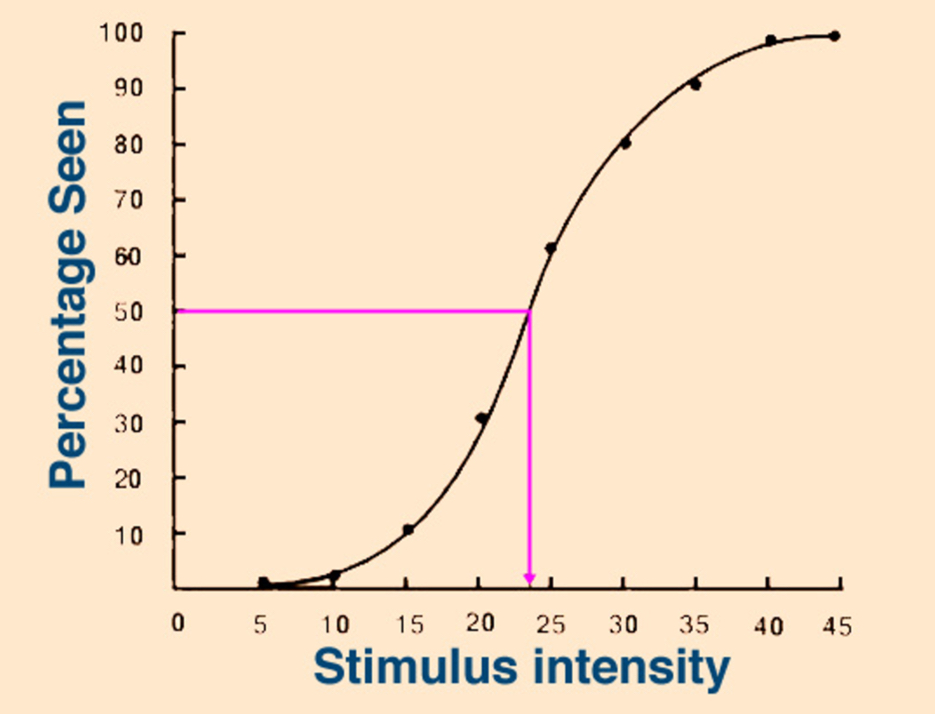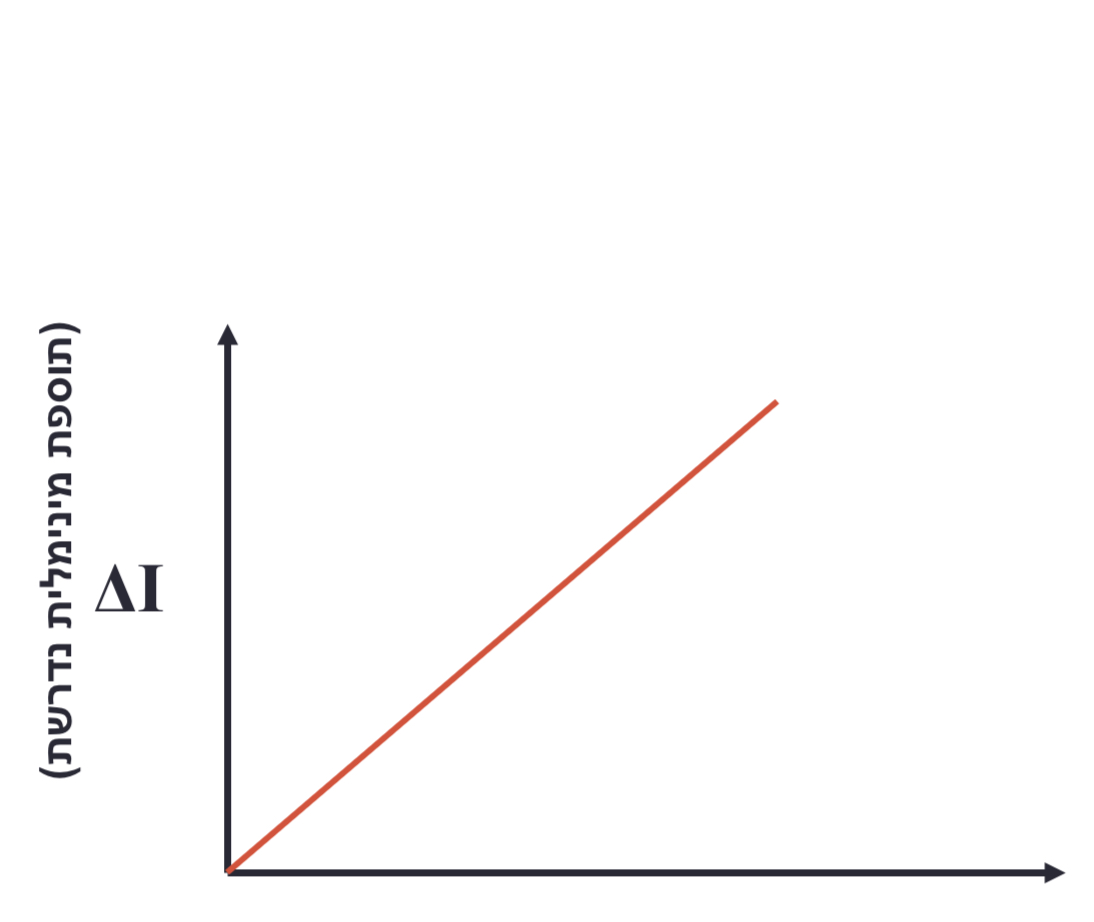Cog Psych 2, 3, 4, 5, 6, 7,8, 9
1/96
There's no tags or description
Looks like no tags are added yet.
Name | Mastery | Learn | Test | Matching | Spaced |
|---|
No study sessions yet.
97 Terms

Absolute Threshold
Minimum stimulus intensity detected 50% of the time.
Difference Threshold (JND)
Smallest detectable difference between stimuli.

Weber’s Law
The ratio of JND to stimulus intensity is constant.

Fechner’s Law
Perceived intensity follows a logarithmic scale.
Signal Detection Theory (SDT)
Differentiating signals from noise, considering both sensitivity and decision bias.
Psychophysics
Studies the relationship between physical stimuli and perception.
Thresholds
Establish limits of perception.
Functional Imaging
Measures brain activity associated with cognitive tasks.
Decision-Making Models
Explain how we process uncertain information.
Trichromatic Theory
The theory that human color vision is based on three primary colors.
Opponent Process Theory
The idea that color perception is controlled by opposing retinal processes (e.g., red-green, blue-yellow)
Binocular Disparity
The difference in images between the two eyes, provides depth perception.
Affordance
The concept that objects suggest their use directly through perception (e.g., a chair affords sitting)
Bottom-up vs. Top-down Processing
Sensory-driven vs. knowledge-driven perception
Gibson's Direct Perception Theory
Suggests perception is immediate and does not require inference.
Gregory's Constructivist Theory
Perception is an active process of hypothesis testing.
Mental Representation
The way information is encoded, stored, and processed in the mind.
Analogical/Pictorial Representations
Resemble real-world objects (e.g., mental images)
Propositional Representations
Abstract and language-based (e.g., "The cat is on the mat").
Picture-like Representations
Function in their own spatial medium
Propositional Code
A different form of representing knowledge
Functional Significance
Images aid memory and cognition (e.g., pictures are recalled better than words)
Mental Rotation
Images behave like real-world objects in space
Image Scanning
The time to scan a mental image correlates with distance
Computational Model (Kosslyn)
Images exist in a spatial medium with defined limits and resolution.
Image generation, interpretation, and transformation are structured processes.
Cognitive Penetrability (Pylyshyn)
Definition: If beliefs/goals alter perception, then perception is not purely functional.
Example: "Imagining something means considering what it would look like if you saw it."
Evidence from Brain Studies
PET and fMRI show overlapping activation for perception and imagery.
Damage to the occipital cortex affects both perception and mental imagery
Double Dissociation
Some patients have imagery deficits but intact perception and vice versa
Aphantasia
The inability to form mental images (Zeman, 2010)
Embodied Cognition
Basic Premise: Cognitive processes are shaped by bodily states and interactions with the environment.
Embodied cognition studies
Handling rough objects affects perceptions of social interactions.
Sitting in a hard chair makes people less likely to compromise.
Holding a warm drink leads to perceiving others as more generous.
Functions of Vision
Object recognition (identifying what is in the environment)
Guiding action based on visual input
Perceptual Organization
How sensory units (lines, spots, etc.) form coherent objects
Gestalt Principles
Figure-ground
Proximity
Similarity
Symmetry
Good continuation
Closure
Pragnanz
Models of Object Recognition
Template Matching
Feature Analysis
Recognition by Components
Computational Model
Template Matching
Comparing perceived images to stored templates
Feature Analysis
Breaking down objects into elemental features
Recognition by Components
Objects are constructed from primitive shapes called "geons"
Computational Model
Primal sketch (basic structure)
2.5D sketch (depth and spatial relations)
3D model (full object representation)
Bottom-Up Processing
Stimulus-driven perception
Top-Down Processing
Expectation and context-driven perception
Agnosia
The inability to recognize objects, people, or sounds despite functioning sensory organs
Apperceptive Agnosia
Failure in shape discrimination despite intact visual functions
Occipital lobe damage (e.g., CO poisoning, head trauma)
Associative Agnosia
Failure to attach meaning to objects despite adequate perception
Temporal and occipito-temporal damage
Prosopagnosia
face blindness
Right hemisphere lesion, particularly in the occipito-temporal region
Pure Alexia
letter-by-letter reading
Capgras Delusion
Emotional recognition disruption despite intact face recognition
Types of ADHD
Inattentive Type
Hyperactive/Impulsive Type
Combined Type
Combined Type ADHD
Features of both inattentiveness and hyperactivity/impulsivity
Hyperactive/Impulsive ADHD
Excessive movement, difficulty waiting, impulsivity
Inattentive ADHD
Difficulty sustaining attention, forgetfulness, distractibility
Continuous Performance Tasks (CPTs)
Measure sustained attention and impulsivity
Visuo-Spatial Orienting Tasks (VOTs)
Assess spatial attention control
Conflict Resolution Tasks (CRTs)
Measure inhibition of automatic responses
Flankers Task
Evaluates attention network efficiency
Attention Network Test (ANT):
Alertness: Reaction time difference between cued and non-cued trials
Orienting: Responses to spatial cues
Control: Ability to manage competing stimuli
Inhibition Model (Barkley)
Core deficit: Poor response inhibition
Impact: Poor executive function, leading to inattention and impulsivity
Filtering out distractions
Interference control
Stopping an ongoing response
Delayed decision making
Inhibition of prepotent responses (Barkley)
Impulse control
Cognitive-Energetic Model (Sergeant, 2005)
ADHD symptoms stem from dysfunction in energy regulation:
Key Insight: ADHD is linked to an inability to regulate energy and maintain task engagement
Dopamine Transfer Deficit (DTD) Model (Tripp & Wickens)
Impaired dopamine response transfer to predictive cues
Weaker anticipatory dopamine release
Treatment for ADHD according to DTD model
Stimulants (e.g., methylphenidate) amplify dopamine responses to predictive cues
Behavioral Effects in DTD model
Difficulty sustaining effort
Poor delayed gratification
Impaired reinforcement learning
Normal Dopamine Process
Initial dopamine response to unexpected rewards
Over time, dopamine shifts to cues predicting rewards
Helps maintain motivation and behavior
Basic categories of attention
Alertness & Arousal
Vigilance
Selective Attention
Alertness & Arousal
Level of information extracted from surroundings
Vigilance
sustained attention over time
Selective attention
Filtering relevant stimuli while ignoring others
Models of Attention
Broadbent's Filter Theory (1958)
Treisman's Attenuation Theory (1960)
Deutsch & Deutsch Late Selection Model
Feature Integration Theory (Treisman)
Broadbent's Filter Theory (1958)
Early selection based on physical properties
Treisman's Attenuation Theory (1960)
Partial filtering with priority processing
Deutsch & Deutsch Late Selection Model
Selection at the response stage
Feature Integration Theory (Treisman)
Attention required for complex feature binding
Spatial Attention
Posner's Paradigm
Object-Based Attention
Posner's Paradigm
Spotlight metaphor, cueing paradigm
Object-Based Attention
Attention can follow objects rather than just spatial locations
Inhibition of Return
Harder to re-attend to previously attended locations
Inattentional & Change Blindness:
Perceiving without attention vs. failure to detect changes
Reticular Activating System (RAS)
Regulates arousal and alertness
Superior & Inferior Colliculi
Eye movement control, visual/auditory attention
Pulvinar Thalamus
Selective filtering and relay of information
Parietal Cortex
spatial attention, hemineglect syndrome
Cingulate Cortex
Conflict resolution, response selection
Executive Control Networks
Dorsal: Goal-directed attention
Ventral: Stimulus-driven attention
Hemineglect Syndrome Characteristics
Ignoring stimuli from one side (typically left neglect from right hemisphere damage)
Affects perception, reading, drawing, and even bodily awareness
Types of Neglect (hemineglect syndrome)
Egocentric: Based on body position
Object-based: Ignoring one half of an object regardless of spatial location
Neuropsychological Tests for hemineglect
Line Bisection Task
Cancellation Tasks
Copying and Drawing Tests
Recovery & Interventions for hemineglect
Sensory stimulation
Awareness training
Motivation-based therapies
Feature Integration Theory (Treisman):
Features detected automatically but need attention for binding
Explains visual search tasks and illusory conjunctions
Inattentional Blindness:
Failure to perceive unexpected stimuli due to lack of attention
Example: Own name detected but similar-sounding words are ignored